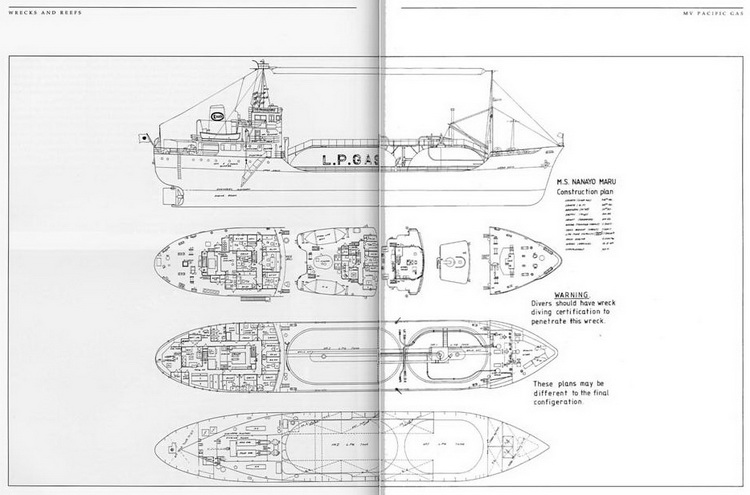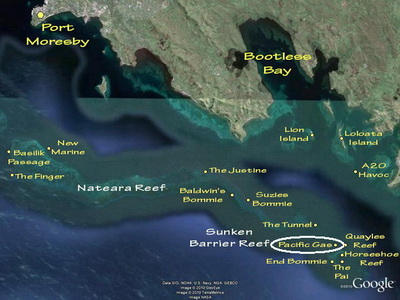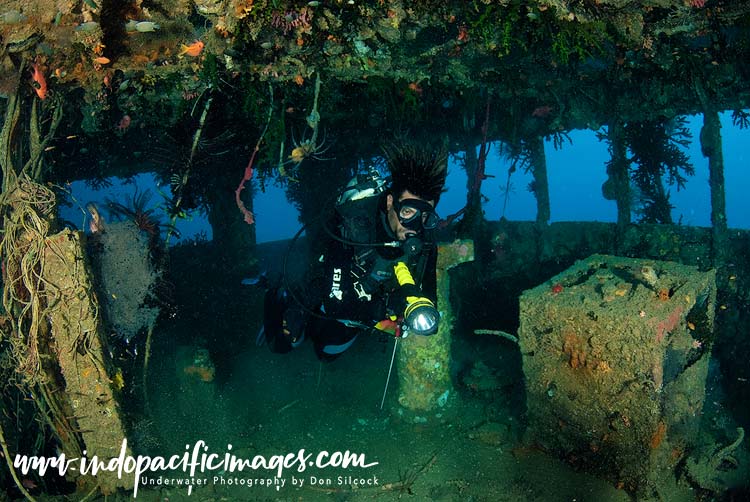The Pacific Gas Wreck… On a good day, and in the right conditions, this is one of the best wreck dives in Papua New Guinea.
However those conditions really do make or break a day out from Port Moresby to dive this site.
The Pacific Gas is located on Horeshoe Reef, part of the offshore reef systems that shelter Port Moresby and Bootless Bay. While the wreck is on the leeward side of the reef and sheltered from the worst of the elements. It is still exposed to big seas in strong winds.
But when the conditions are good, the wreck really is a great dive!
Pacific Gas Wreck – The Backstory
The Pacific Gas started its life in Hiroshima, Japan in 1967 as the MS Nanayo Maru. Built by the Kanawa Dock Company as a liquefied gas carrier for its owners Okuda Gyogyo KK.
It then went into service as a Japanese merchant ship transporting gas cargoes between Japan, Taiwan and Singapore. With the liquefied gas stored in two large cylindrical, refrigerated vessels located in the middle section of the ship.
In 1972 the Nanayo Maru was sold to the Australian company Liquefied Gas Carriers. Renamed as the MV Pacific Gas, the ship then went into service transporting gas cargoes between Australia and PNG for Boral Gas.

Then, in 1980 it was assessed as being at the end of its effective operating life. As part of it’s de-commissioning the gas storage vessels were removed and installed on dry land at the Boral Gas facilities in Port Moresby and Lae.


The hull of the ship was then sold to a group of enterprising Port Moresby businessmen. Led by the prominent politician Sir Hugo Berghauser, who planned to run it aground on Ela Beach and convert it into a seafood restaurant & nightclub…
However permission to ground the Pacific Gas was refused by Port Moresby’s Town Planner. So the Pacific Gas ended up moored in the harbor until June 1986. When, after several missed deadlines to remove the vessel because of its poor condition, the Harbors Board issued a final ultimatum to remove the ship within 14 days.
Bob Halstead…
Bob Halstead is best known for his role in pioneering the liveaboard dive industry in Milne Bay with his boat the Telita. But he actually started his diving business in Port Moresby back in 1976 with his wife Dinah. And they both played a major role in the final resting place of the Pacific Gas.
Their diving business was called Tropical Diving Adventures and it catered for both local and tourist divers. Concentrating on the offshore reefs from Port Moresby and Bootless Bay for their open water dives. Then in 1978 Bob enlisted the help of the Port Moresby Sub-Aqua Club to create the first wreck dives in the area.
Two condemned ex-government vessels, the MV Parama and the MV Jade, were to be towed out to sea and scuttled. But instead the Halsteads and the Sub-Aqua Club were able to get them sunk near Horseshoe Reef, south of Bootless Bay. When Bob heard about the final ultimatum from the Harbors Board, he approached Sir Hugo. Ultimately convincing him that the best solution to the problem was for the Pacific Gas to join the growing list of wrecks near Horseshoe Reef.
The Sinking of the MV Pacific Gas
This is how Bob Halstead described the actual sinking of the Pacific Gas… “Pacific Salvage cleaned up the vessel and towed it out to a spot I had marked in the shelter of Horseshoe Reef with the stern in 40m of water.
We moored the ship and Ian Short, a local commercial diver & explosives expert, planted the explosive charges which worked perfectly and sank the Pacific Gas in just 12 minutes.
The bow hit the bottom first giving it a ding, and then the rest of the vessel sank perfectly upright with the stern in 43 m of water. There are photos of the vessel sinking which I will get for you.

At the same time we started operating Telita in Milne Bay and moved our operation from Bootless so we actually missed out on many of the benefits of the sinking, but it is a wonderful dive and I am proud of it.”

Diving the MV Pacific Gas
Laying as it does on the slope of the Sunken Barrier Reef, with its bow in 18m of water.
The logical way of diving this excellent wreck is to descend using the mooring line on to the bow, which is in 18m of water.
There is a lot to see around the bow, but it’s best to bypass this area and save it for the end.
As there are some far more interesting things to see down deeper around the bridge area and down at the stern!
The mid-section of the wreck is where the large LPG storage tanks used to be. They have left some very large holes…

Diving the Pacific Gas Wreck – The Bridge Area
Prior to sinking the Pacific Gas all the glass in the bridge wheelhouse was removed which has allowed the now resident population of snapper, sweetlips, puffer and angel fish to roam around at will. Plus it’s easy and relatively safe to squeeze in through the open doorways and enter the wheelhouse itself as there are also no doors to worry about closing on you once inside.
The area to the rear of the wheelhouse has much to see, with it’s derricks and handrails rich in soft corals and the Tubastrea hard coral, but by now you are in around 30m of water and your bottom time and air supply have to be monitored carefully as the best bit is still to come.

Diving the Pacific Gas Wreck – The Stern
Descending further towards the stern presents a superb view back up the whole length of the ship.
If you swim out from the stern in to open water, at about 40m you can take in the tremendous vista of the wreck.
That was “the image” I really wanted as it captures the ethos of the Pacific Gas wreck and it’s location on the slope near Horseshoe Reef.
It took me two dives to actually get it and Franco (AKA Francis Tolewa), my incredibly patient Loloata dive guide was the perfect model.
Even to the point of somehow making his dreadlocks stand up so that they were silhouetted against the sunlight!
The angle that the wreck lies at makes the ascent fairly easy once the depths around the stern have been sampled. As you simply head back up to the wheelhouse and then up to the bow.
If you have enough air left it’s well worth exploring around the coral encrusted winch and hatches at the bow.
As there is a assortment of critters such as ghost pipefish and leaf scorpion fish to be found there.

Back To: A Guide to Diving Port Moresby
